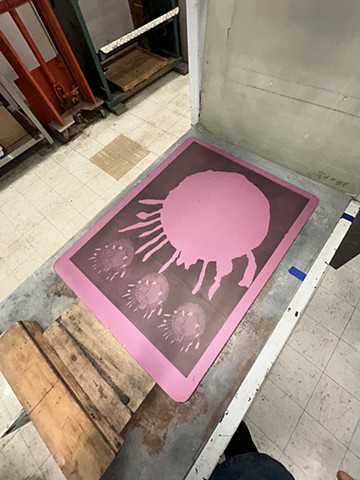about

Through process-driven play, my work explores the eclectic tendencies of humanity, marrying familiar with whimsy. I use the tactile processes of printmaking and drawing to convey spaces that articulate moods hovering between charming and deranged states. My work is devoted to loud colors and anthropomorphized imagery, and drawing remains my most crucial tool. I particularly adore drawing’s direct relationship to mood, driven by tone and tension. I often splice together shrouds of color and crude gesture to depict attitude and agitation, noise and warmth, distortion and warping.
Odd, turbulent scenes in my work convey my own fixations and rabbit holes, recently medieval stripes, 60s Funk art, circus animals, and checkerboard flooring. Love of mischief, play, and nonsense feed my obsession with irreverent humor, notably demonstrated in the Monty Python movies. Recently, I’ve relied on patterns–askew and wonky–as a way of gesturing to weird affective moments in contemporary life by using repetitive motifs like seahorses, stripes, cakes, and stage curtains. I use busy patterns directly as a means of initially captivating the viewer, and like the artists in Nicole Archer’s article Dynamic Static, I am excited how visual patterns can prompt moral contemplation. I seek to highlight the drollery of the mundane manner of day to day routines, using patterns as stand in for structure. Such explorations into monotony and disconcertedness unfold alongside cheeky moments and seeking humor in the mundane.
The characters that populate my compositions are at the same time cute and off putting; whether swimming in groups or enclosed in birthday cakes they interrupt their aesthetic landscapes with dazed expressions and wide eyes that beg for attention. The movement of the figures in each piece emit a desperate but silly energy when combined with wobbly rendered lines and direct eye contact. The forms are placed on display, like puppets, yet crane their misshapen bodies to stare directly at the viewer, creating real empathy in their weirdness. I prefer to embrace the idea of relying on the absurdity of these characters and situations rather than clear narratives. Funk artists like Jim Nutt used absurdity to create a window into deeper reflection; Funk art is bold and raunchy, making many subtle declarations and reflections that can be easily missed. In an interview, Jim Nutt describes the visual information in his work as, “providing food for thought rather than collating the thought” (Nutt 1994, 51), and the “ [the viewer’s] response to [the imagery’s] magnetic attraction depends on our openness to the integrity of mystery and the realms of possibility and surprise.” (Nutt 1994, 56). I seek to beckon a similar curiosity in my viewer, by creating landscapes that provoke the viewer to ponder their own moral structures, indulgences, desires, vices, and quirks. I like to think that each page is a surface occupied by flat shapes and whimsical drawing, but the moments of pattern jamming and noise in them foster an arena for contemplation and reflection.